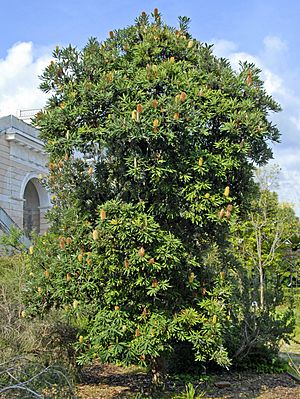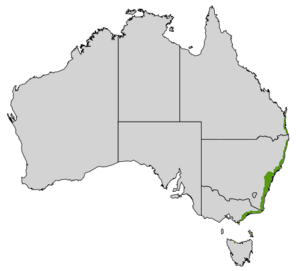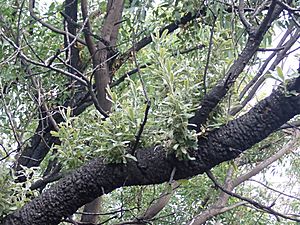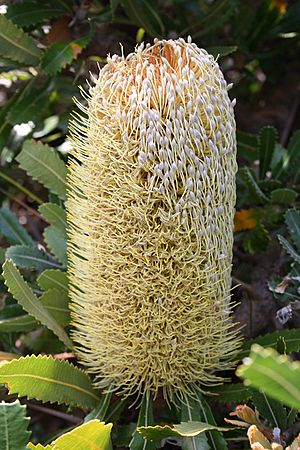Saw banksia facts for kids
Quick facts for kids Saw banksia |
|
|---|---|
 |
|
| Tree of Banksia serrata at Villa Durazzo-Pallavicini | |
| Scientific classification | |
| Kingdom: | |
| (unranked): | |
| (unranked): | |
| Order: | |
| Family: | |
| Genus: | |
| Subgenus: | |
| Section: | |
| Series: | |
| Species: |
B. serrata
|
| Binomial name | |
| Banksia serrata L.f.
|
|
 |
|
| Range of Banksia serrata in green | |
| Synonyms | |
|
|
The Saw banksia (Banksia serrata) is a special type of shrub or tree. People also call it the old man banksia or red honeysuckle. The Cadigal people, who are Indigenous Australians, call it wiriyagan.
This plant grows naturally along the east coast of Australia. You can find it from Queensland all the way down to Victoria. It even has small groups of plants on Tasmania and Flinders Island. The saw banksia often looks like a twisted tree. It can grow up to 16 meters (50 feet) tall. In windy places, it might be much smaller.
The saw banksia has bumpy grey bark and shiny, dark green leaves. Its leaves have jagged edges, like a saw. In summer, it grows large yellow or grey-yellow flower spikes. After the flowers are pollinated, they turn grey. Then, they form big, woody seed pods called follicles.
Banksia serrata was one of the first four Banksia species ever collected. Sir Joseph Banks found it in 1770. It was officially named in 1782 by Carolus Linnaeus the Younger. This plant loves sandy soil and often grows in scrubland or open woodland. Many animals, like birds and insects, visit its flowers for food. It's also a popular plant for gardens.
Contents
What the Saw Banksia Looks Like
The saw banksia usually grows as a twisted, uneven tree. It can reach up to 16 meters (50 feet) tall. But near the coast, it might be a small shrub, only 1 to 3 meters (3 to 10 feet) high. On very windy cliffs, it can even grow flat along the ground.
As a tree, it usually has one strong trunk. The bark is bumpy and grey, up to 3 cm (1.2 inches) thick. Often, the trunks are black from past bushfires. If the tree gets hurt, red sap might ooze out. New branches grow in spring, summer, and autumn. Young branches are hairy for a few years.
The leaves usually grow close together at the ends of branches. This makes the tree look a bit sparse. The leaves are dark green on top and lighter green underneath. They are about 7 to 20 cm (3 to 8 inches) long and 2 to 4 cm (0.8 to 1.6 inches) wide. Their edges are serrated, meaning they have small, saw-like teeth.
Flowers and Seed Pods
The flowers grow in cylindrical spikes. These spikes come from the ends of branches that are one or two years old. Leaves grow at the base of the spikes. Each spike is usually 9 to 12 cm (3.5 to 4.7 inches) wide. Hundreds of tiny flowers grow on a woody stem inside the spike. The stem is 7 to 15 cm (2.8 to 5.9 inches) tall.
The flowers are cream-grey with cream-colored parts called styles. After pollination, the old flower spikes turn into "cones." These cones can have up to thirty woody seed pods, called follicles. Old flower parts stay on the cones, making them look hairy. Each follicle is oval-shaped and wrinkled. It is covered with fine hair. They are about 2.5 to 3.5 cm (1 to 1.4 inches) long.
Seeds and Seedlings
The seeds are about 3 to 3.4 cm (1.2 to 1.3 inches) long. They are quite flat and have a papery wing. Each seed weighs about 77.5 milligrams. The seed body, which holds the baby plant, is about 1 to 1.2 cm (0.4 to 0.5 inches) long. One side of the seed is dark brown and pitted. The other side is brown-black and slightly shiny.
A sturdy, dark brown separator keeps the seeds apart inside the follicle. When a saw banksia seed sprouts, its first two leaves are called cotyledons. They are dull green and about 1 to 1.4 cm (0.4 to 0.5 inches) long. The stem of the seedling is thick, hairy, and red. Later leaves are longer, with serrated edges.
How it's Different from Similar Plants
The saw banksia looks a lot like another plant called Banksia aemula. But you can tell them apart by their trunks. B. aemula has an orange-brown trunk, while B. serrata has a greyish one. Also, the adult leaves of B. aemula are narrower. The flowers of B. serrata are usually a duller grey-yellow. Its seed pods are also smaller.
How the Saw Banksia Got Its Name
Banksia serrata was first found at Botany Bay in Australia. This happened on April 29, 1770. Sir Joseph Banks and Daniel Solander, who were naturalists, collected it. They were on Captain James Cook's ship, the HMS Endeavour.
The plant was officially described in April 1782. Carolus Linnaeus the Younger named it in his book Supplementum Plantarum. He said it was the most beautiful species in the Banksia group. Because it was the first Banksia named, Banksia serrata is the "type species" for the whole genus.
People call it the old man banksia, saw banksia, or saw-toothed banksia. It's also known as red honeysuckle because of its timber's color. The Cadigal people, who lived in the Sydney area, called it wiriyagan.
Over time, other botanists tried to give it different names. For example, Joseph Gaertner called it Banksia conchifera in 1788. Joseph Knight used names like Banksia mitis and Banksia serræfolia in 1809. But these names were later found to be incorrect or unnecessary. In 1830, John Lindley named a plant Banksia undulata, thinking it might be a wavy-leaved type of B. serrata.
Its Place in the Plant Family Tree
Scientists group plants to understand how they are related. In 1981, Alex George created a new way to classify Banksia plants. He put B. serrata into a group called Banksia subgenus Banksia. Then, he placed it in a section called Banksia section Banksia. Finally, it was put into a series called Banksia series Banksia.
This series includes other well-known banksias. Some of these are Banksia aemula, B. ornata, and B. speciosa. These plants are all closely related.
More recently, scientists have used DNA to study how plants are related. In 2005, Austin Mast and his team studied Banksia DNA. Their findings suggested that the saw banksia and its close relatives form a natural group. This research helps scientists understand the true family tree of these amazing plants.
Where the Saw Banksia Lives
The saw banksia grows naturally in eastern Australia. You can find it from Wilsons Promontory, Victoria, in the south. It stretches up to Maryborough, Queensland in the north. There are also groups of these trees in Tasmania and on Flinders Island. On Flinders Island, there are about 60 to 80 old trees. They seem to be growing new plants even without fires.
This plant likes sandy soils that drain well. These soils usually don't have many nutrients. You often find it near the coast, just behind the sand dunes. In the Sydney area, it grows with other native trees. These include yellow bloodwood, red bloodwood, and Sydney peppermint.
In some areas, B. serrata grows on newer sandy soils. Its close relative, B. aemula, prefers very old sandy soils. Sometimes, you can find both species growing together. The saw banksia is also part of a special plant community. This community is called the Eastern Suburbs Banksia Scrub. It is considered an endangered ecological community.
Animals and the Saw Banksia

The saw banksia is a very important food source for many animals. Birds that eat nectar love its flowers. These include bell miners, noisy miners, white-cheeked honeyeaters, and rainbow lorikeets. Many other types of honeyeaters also visit the flowers.
The young seed pods are a tasty snack for yellow-tailed black cockatoos. These large black birds enjoy eating them.
Studies have shown that most saw banksia flowers open at night. Small mammals also visit the flowers. These include the brown antechinus, sugar glider, and eastern pygmy possum. These animals help to pollinate the flowers. Other mammals like grey-headed flying foxes also eat the flowers. Native bees and European honey bees also visit the flowers.
The saw banksia has a main root that goes deep into the ground. It also has special roots called proteoid roots. These roots are very good at taking nutrients from poor soils. This is important because Australian soils often lack nutrients like phosphorus.
Some saw banksias can get sick from a disease called dieback. This disease is caused by a tiny organism called Phytophthora cinnamomi. Plants growing in sandy soils are often more resistant to this disease.
How People Use the Saw Banksia
In Gardens
The saw banksia is a popular plant for gardens. Its bumpy bark, saw-toothed leaves, and silvery-yellow flower spikes make it interesting. You can easily grow it from seeds. You just need to heat the "cone" to release the seeds.
When planting, it's best to use well-drained, sandy soil. It likes sunny spots. Watering it in summer helps it grow well. It might take a few years for the plant to flower. However, plants grown from cuttings can flower in just two years. The saw banksia is also used in bonsai, which is the art of growing miniature trees.
For Building
The wood of the saw banksia is reddish-pink. It looks a bit like English oak. It's strong, lasts a long time, and has a unique pattern. Because of these qualities, it has been used to build boats.
Special Types of Saw Banksia
- Banksia 'Pygmy Possum' – This is a special type that grows flat along the ground. It's great for rock gardens or small spaces. You might see similar plants called B. serrata (Prostrate) in nurseries.
- Banksia 'Superman' – This type has very large flowers, up to 27 cm (10.6 inches) high, and big leaves. It's not widely sold yet, but it's officially registered.
Images for kids
-
Banksia 'Pygmy Possum' at the Royal Botanic Gardens, Cranbourne
See also
 In Spanish: Old man banksia para niños
In Spanish: Old man banksia para niños






